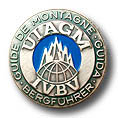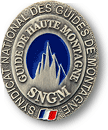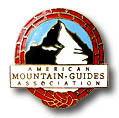CLOTHING
Mountaineering Boots - The climbing in the Alps varies tremendously. Some routes are all snow and ice while others include much rock scrambling. For this reason you will want to carefully match your footwear to the type of routes you are likely to undertake. In general, if your climbs involve much rock scrambling you will want a boot that performs well on this terrain–lightweight and agile. On the other hand, for routes to very high altitudes (Mont Blanc or Monte Rosa, for example), and north-facing ice climbs, you may want a bit more support and warmth.
Unfortunately, no boot will do a good job with every type of climbing, and often a compromise is needed. However, we can offer the following general guidelines:
If your goals include big peaks with lot of rock, such as the Matterhorn or the Eiger, you will want a boot that weighs 1.5 kilos per pair or less. Good example of this are – Sportiva: Trango Cube, or Trango S Evo GTX. Millet: Grepon GTX. Scarpa: Rebel or Rebel Pro GTX.
If your goals lean more toward big snowy peaks, at high altitudes, glacier ascents, or generally less technical climbing, a slightly heavier boot of about 2 kilos per pair may be appropriate. Good examples here include the – Sportiva: Nepal Evo, or Nepal Cube. Millet: Brenva Evo. Scarpa: Mont Blanc or Mont Blanc Pro.
Rock climbing shoes - Not too tight for long routes. These can be rented on a per-day basis major alpine climbing centers.
Gaiters - In summer conditions an ankle gaiter is sufficient, is cool to walk in and weighs almost nothing. If your pants are effective at keeping snow out of your boots, then you may not even need this.
Socks - Fit your trekking or mountaineering boots with a single mid-weight sock. If we are staying in huts for several nights in a row, then you may prefer to bring two changes of socks: one for the approach and a nice clean fluffy pair for summit day or to wear on alternate days to allow for a brief wash and dry.
In huts, we often bring an additional pair of very light socks, just to escape from our warmer socks.
Pants - In our opinion the best pants incorporate Schoeller or a similar light soft-shell type fabric. Stretchy and comfortable, this kind of fabric is also somewhat resistant to wind, snow and light rain. Many pants of this kind are made by both U.S. and European manufacturers.
Rain/Wind Pants - Normally we do these climbs in our synthetic climbing pants described above. If the weather turns foul, however, you will need a pair of very lightweight waterproof rain pants to keep you dry. Our favorites are extremely light weight two-ply Gore-tex. Our pants weigh 8.5 ounces.
Rain/Wind Parka - Again, go for extreme lightweight.
Long Underwear Tops - A light synthetic or very light merino wool base layer. You might want to bring both a longand short-sleeved version of this.
Long Underwear bottoms - Light synthetic or wool.
Hut Socks - We like to bring a light pair of socks to switch into when in the hut. One pair is plenty.
Hut pants (optional) - We often like to bring a very light pair of shorts, or "yoga" tights to change into in the huts. This is a luxury item, so keep them as light as possible.
Light insulating shirt - Something about the weight very heavy synthetic underwear.
Medium weight insulating layer - For another warm layer, you might consider a lightly insulated nylon shirt/jacket such as the Marmot's DriClime windshirt.
Heavier insulating layer - A light-weight down or synthetic insulated sweater or pull-over. Marmot's Zeus jacket or Patagonia's Nano Puff Hoody are good examples of what we mean.
Light Gloves - Most of the time you will be comfortable with a pair of simple "WindStopper" gloves.
Gloves - On higher glaciated climbs such as Mont Blanc we would normally bring two pair of gloves; one is a fairly warm shelled glove for cold mornings, and the second is a lighter liner type glove with a durable palm. WindStopper is a good material for this second type of glove.
Baseball cap or other sun-hat with a brim -
Neck Gaiter - The "Buff" is a Spanish invention. Its a stretchy lightweight neck gaiter, ear warmer, headband, pirate head piece, hair control unit, and Lord knows what else. Google "Buff" to learn more. Indispensable!
Around-town clothes and shoes -
CLIMBING GEAR
Ice Axe - 50 to 60 cm maximum length is recommended. Again, look for a light weight axe for this purpose. For many nontechnical glacier climbs (and even on some steep terrain) our preferred axe is the light 52 cm Petzl Summit or Summit Evo axe, or slightly more technical Petzl Sum'Tec. All of these axes weigh in at 500 grams or less.
Technical ice tools - If your program and interests include some steeper ice, bring a pair or technical ice tools. These can also be hired in Chamonix.
Crampons - The best crampons for alpine climbing are easy to adjust in the field, easily fit most boot types, and have a flat frame. This last quality makes them "ball up" much less in sticky snow. The Petzl Vasak is a great example.
For Alpine climbing, avoid crampons with vertically oriented frames sometimes seen in waterfall climbing crampons, as these ball up so easily as to be downright dangerous in some snow conditions. Crampons with vertical front points are likewise not recommended for general alpine climbing.
Crampon anti-balling plates - These are rubber or plastic plates which fit under your crampons to prevent snow balling up—an annoying and potentially dangerous problem. Most crampon manufacturers have models designed specifically for their crampons and most are now sold with an integral plate.
Harness - Most modern harnesses are great. A belay loop is essential. Look for a lightweight harness. The CAMP Alpine Flash is a good example.
Rappel/Belay device - Such as the Black Diamond ATC-Guide, or Petzl Reverso 4.
Climbing helmet - Go for light weight. The Petal Meteor or Scirocco are good examples.
Locking Carabiners - Bring two locking carabiners for use with your belay device and anchoring. Go for light weight, less than 60 grams. The Petal Spirit Screw-Lock or Sm'D are good examples.
Trekking Poles - (optional) Some folks, ourselves included, like to use trekking poles. Three-section foldable (as opposed to telescoping) trekking poles are best, as they collapse shorter, are lighter, and are less cumbersome when packed.
Avoid poles with "shock absorbers", they add unnecessary length and weight, without adding any significant benefit. The Leki Micro Vario Carbon is our favorite. Be sure you bring the baskets!
MISCELLANEOUS
Pack - A simple and lightweight pack with a capacity of about 30 liters is recommended. The Black Diamond Speed 30, The Millet Prolighter 30+10, and also the Deuter Guide Lite are some good choices.
Food - Breakfasts and dinners are eaten in town or in the huts. You can have the hut make you a sack lunch as well (they will charge you for it). If you have a special snack food you can't live without, you most definitely should bring some of that with you though remember to keep it light. We recommend getting lunches from the huts. All of the huts can cater to vegetarians (the normal dinner usually includes some meat). If you would like to go veggie, please tell us so we can make our request to the guardian.
Food - Breakfasts and dinners are eaten in town or in the huts. You can have the hut make you a sack lunch as well (they will charge you for it). If you have a special snack food you can't live without, you most definitely should bring some of that with you though remember to keep it light. We recommend getting lunches from the huts. All of the huts can cater to vegetarians (the normal dinner usually includes some meat). If you would like to go veggie, please tell us so we can make our request to the guardian.
Water bottle or Thermos - Bring bottles or a combination of bottle and thermos to carry 1 - 2 liters of water. On snowy 4000 meter peaks a Thermos is a nice luxury.
On very cold and high climbs bladder style hydrations systems will likely freeze up on our pre-dawn start, and are recommended only if you have lots of experience using them in very cold weather, i.e. you can keep the hose consistenly clear of fluid when not in use.
For trekking where temps are generally not so low, water bottles or a bladder work well.
On climbs like the Matterhorn, where weight is to be avoided if at all possible, leave the thremos in the hotel.
Head lamp - For this program we recommend a bright but lightweight headlamp such as the Petzl Actik Core.
Pocket knife - Keep it simple and light. The Victorinox Spartan model is our favorite.
Blister kit - Moleskin, athletic tape. Spenco Second Skin or Compeed is well worth the price.
Sun Glasses - Modern wrap-around glasses are great, if the lenses are dark enough to block 90% of visible light (it's very bright up there!). Traditional glacier glasses with side shields are also fine for this program, though you may find them hot and annoying on the trail or approach. If you use prescription glasses you should get prescription dark glasses or use contact lenses if you can. We like to use sport sunglasses with dark lenses, designed for skiing or mountaineering.
Sunscreen - Look for as small a container as possible, or decant into a smaller container. There is no point in carrying month's worth of cream on a short outing.
Lip Protection - with sun screen.
Toiletries - Here again, try to minimize, for instance look for those small tubes of toothpaste. If you like bring 4 or 5 "handi-wipes" or similar.
Ear Plugs - VERY IMPORTANT! For noisy huts.
Sleeping liner - Most hut now require the use of sleeping liners. Find the lightest one you can. Silk, or silk and cotton blend liners typically weigh about 110 grams (4 ounces). Do NOT bring an insulated sack. The sack is for hygiene and comfort, but not for insulation.
We have loaners you are welcome to use (we wash them after every trip). Or you can bring your own, or purchase one from the first hut.
Camera - (optional, of course) It is very helpful to have a small camera bag that can be hung around the neck, attached to the pack, or stuffed in a pocket so that it is handy, but doesn't interfere with movement. Please don't carry your camera inside your pack.
Most phones can take great pictures but are easy to drop and limited battery life.
Mobile phone (optional) - Many folks like to carry phones. In general, this is a good idea from a security perspective. Be aware, however, that battery life is limited, especially when the phone is searching for a service provider as it may often do in this remote setting, so you will probably need to leave it turned off except when making a call. Watching movies or playing games on your phone also consumes a lot of battery power. Keep your phone in "airplane" mode to save power. Sorry, no wifi.
Entertainment (optional) - Preload your phone with a couple of good books from Audible.com or your local library for days of listening pleasure. Snipped-out New York Times crossword puzzles, a journal, small paperbacks, or a pack of cards. All could be fun to have along.
Phone and camera charging - Some huts (though not all) have a charging station for your use. If you need to charge electronics, bring the appropriate cable as well as a Swiss/Euro (squashed hexagon) to USB adapter. Passport, or photocopy - We prefer to leave our passports, plane tickets, etc. safely in the lowlands and carry only a photocopy on the tour. But some folks feel naked without it, and for them it is best to carry it.
Small duffel - For leaving street clothes in hotels. Its a good idea to lock it.
Money - We usually use ATM cards to supply us with cash. Hotels, shops, most huts and restaurants accept credit cards. You'll need cash, however for hut extras and any remote restaurants. We recommend leaving your passport and similar valuables with your baggage in the hotel, awaiting your return.
GaiaGPS - For those of you who like to track our progress, we highly recommend the GaiaGPS mobile app. The Pro version ($40 per year) gives you access to many European maps (including Norway, France, Austria and Switzerland).
|



